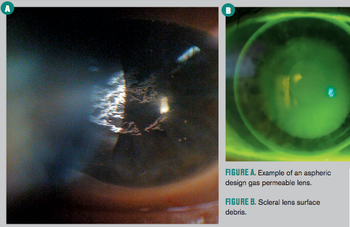
In Part 2 of her three-part series on cosmetic dangers, Tracy Schroeder-Swartz, OD, MS, FAAO, focuses on the dangers found in cosmetics-particularly cosmetics banned by the FDA and those that may exacerbate ocular surface disease.


In Part 2 of her three-part series on cosmetic dangers, Tracy Schroeder-Swartz, OD, MS, FAAO, focuses on the dangers found in cosmetics-particularly cosmetics banned by the FDA and those that may exacerbate ocular surface disease.

Comprehensive ocular examinations can provide an OD with an inside look into a patient's health. Mile Brujic, OD, and David Kading, OD, discuss the importance of using upper eyelid eversion during the exam to unleash significant information about a patient's ocular surface and systemic health.

Michael Cooper, OD, takes a look at how the Japanese treat allergic conjunctivitis to gain a different perspective on treatments. What he finds is that we aren't so different after all.

In Part 1 of her three-part series on cosmetic dangers, Tracy Schroeder-Swartz, OD, MS, FAAO, outlines what types of cosmetic products are available and what they do.

Dry eye disease (DED) has been historically underserved. Leslie E. O’Dell, OD, FAAO, summarizes what equipment is available today to help you begin evaluating your dry eye patients’ glands.

The Precision Medicine Initiative offers a model to customize treatment for each individual patient. Katherine M. Mastrota, MS, OD, FAAO, Dipl ABO explains why using precision medicine to treat dry eye disease can be beneficial for the OD and patient.

If you have skimmed a few summary articles and are thinking, “Dry eye not really changed much for me,” we’re highlighting the biggest takeaways from TFOS DEWS II that will make you rethink what you think you know about dry eye treatment in our podcast with Drs. Jennifer Craig, Lyndon Jones, and James Wolffsohn.

Whether your Halloween makeup plans are glamorous or ghoulish, incorrect makeup practices are frightful for eye health.

Electronic cigarettes (e-cigarettes) are devices designed to deliver nicotine in a solution rather than smoke without tobacco combustion. Perceived by consumers as a safer alternative to conventional cigarettes, e-cigarettes are aggressively marketed as lifestyle-choice consumables.

As ODs, we are fully aware of the challenge patient compliance with prescribed eye drops. To assuage the battle of compliance, eye drop manufacturers are assiduously working to devise drug delivery systems that reduce or eliminate patients’ engagement in the instillation of their prescribed therapy. But until ODs no longer use eye drops, drops remain our primary mode of drug delivery.

To understand how far we have come, you must remember where we started.


A poor ocular surface is a common condition in glaucoma patients due to the incidence of dry eye, age, and use of benzalkonium chloride (BAK). Poor compliance with glaucoma therapy can result. Use of point-of-care testing can help identify patients with a poor ocular surface and drive treatment decisions. Treatment options, including surgical, are discussed.

Neurostimulation could be the “next big thing” in dry eye disease (DED). A new neurostimulation device called TrueTear (Allergan) is a patient-directed, non-pharmacologic option.

With great anticipation, the updated report of the TFOS Dry Eye WorkShop (DEWS II) was released last week. The first DEWS report was released in 2007.

So much basic science research is presented at this meeting, and most of it will be years before it makes its way to clinical trials. Let’s concentrate on research that might be of use to us in the exam room very soon.

Scott Schachter, OD, discusses dry eye and how incorporating a dry eye checklist may help improve patient treatment.

Optometry Times Editorial Advisory Board members Leslie E. O’Dell. OD, FAAO, and Scott Hauswirth, OD, FAAO, discuss their recent lecture on inflammation and the role it plays in ocular surface diseases at the American Optometric Association’s Optometry’s Meeting in Washington, DC.

https://www.optometrytimes.com/modern-medicine-cases/new-player-point-care-allergy-testingODs undervalue ocular point-of-care tear testing

Improve your scleral fitting skills and your patients’ quality of life

The British Contact Lens Association (BCLA) celebrated its 40th birthday June 9-11 at its 2017 clinical conference and exhibition in Liverpool, UK. Optometry Times was there to hear the latest and live tweet from the meeting.

At every age we need adequate, uninterrupted sleep for optimal, wakeful functioning. Insufficient sleep is associated with a number of chronic diseases and conditions such as diabetes, cardiovascular disease, obesity, and depression.

What is this age-defying modern technology that a young, nonmedical professional is applying to her face? It is a YAG laser combined with an intense pulse light (IPL).

David Kading, OD, FAAO, FCLSA, discusses new products, studies, and patient education available to help combat dry eye disease.

Meibomian gland dysfunction (MGD) may be misdiagnosed. While MGD is one of the most common chronic ocular conditions, diagnosing MGD isn’t as simple as it seems.